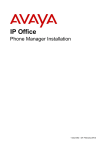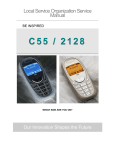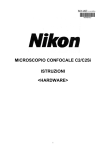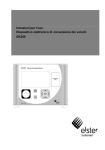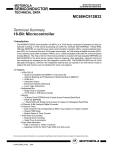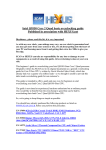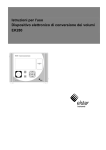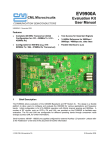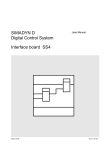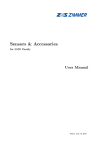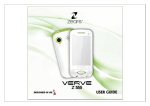Download Siemens SL45 Service Manual V1.0
Transcript
SL45 Level 2.5e Repair Documentation V 1.0 by Toko ([email protected]) V1.0 SL45 Page 1 of 43 Company Confidential ICM MP CC ST 10/01 Table of Contents: 1. LIST OF AVAILABLE LEVEL 2,5E PARTS SL45 .............................................. 4 2. REQUIRED EQUIPMENT FOR LEVEL 2,5E SL45.............................................. 5 3. REQUIRED SOFTWARE FOR LEVEL 2,5E SL45 .............................................. 5 4. RADIO PART ....................................................................................................... 6 4.1. Power Supply RF-Part.......................................................................................................................... 6 4.2. Frequency generation ........................................................................................................................... 7 4.2.1. Synthesizer: The discrete VCXO (13MHz) .................................................................................... 7 4.2.2. Synthesizer: LO1............................................................................................................................. 8 4.2.3. Synthesizer: LO2............................................................................................................................. 9 4.2.4. Synthesizer: PLL........................................................................................................................... 10 4.3. Antenna switch (electrical/mechenical) ............................................................................................. 11 4.4. Receivers .............................................................................................................................................. 13 4.4.1. Receiver: GSM900/1800 –Filter and LNA ................................................................................... 13 4.4.2. Receiver : Mixer, IF Amplifier and Demodulator......................................................................... 14 4.4.3. Smarti IC Overview ...................................................................................................................... 15 4.5. Transmitter.......................................................................................................................................... 16 4.5.1. Transmitter: Modulator and Up-conversion Loop ........................................................................ 16 4.5.2. Transmitter: Power Amplifier and Antenna Switch...................................................................... 17 5. POWER SUPPLY............................................................................................... 19 5.1. Overview and Voltages ....................................................................................................................... 19 5.2. STV-Schalke-ASIC ............................................................................................................................. 20 5.3. Power Supply MP3 (LARA)............................................................................................................... 24 6.LOGIC PART ........................................................................................................ 25 6.1. Overview Logic................................................................................................................................... 25 6.2. Overview EGOLD+............................................................................................................................ 26 6.3. Overview EGAIM ............................................................................................................................... 28 6.4. Overview MMG ASIC ....................................................................................................................... 31 6.5. MP3 (LARA) HW components .......................................................................................................... 32 6.6. FLASH memory .................................................................................................................................. 33 6.7. Real time clock inside the EGOLD+.................................................................................................. 33 6.8. IrDA ..................................................................................................................................................... 33 V1.0 SL45 Page 2 of 43 Company Confidential ICM MP CC ST 10/01 6.9. SIM ....................................................................................................................................................... 34 7. ACOUSTICS ...................................................................................................... 34 7.1. General................................................................................................................................................. 34 7.2. Vibra..................................................................................................................................................... 34 7.3. Microphone.......................................................................................................................................... 35 7.4. Loudspeaker ........................................................................................................................................ 36 8. ILLUMINATION AND KEYBOARD:................................................................... 39 8.1. Illumination ......................................................................................................................................... 39 8.2. Keyboard ............................................................................................................................................. 40 9. CONNECTORS .................................................................................................. 41 9.1 I/O connector ....................................................................................................................................... 41 9.2 Battery connector................................................................................................................................ 42 9.3 Display connector................................................................................................................................ 42 9.4 MMI connector.................................................................................................................................... 43 V1.0 SL45 Page 3 of 43 Company Confidential ICM MP CC ST 10/01 1. List of available level 2,5e parts SL45 ID-No Type Name(function)/Location Rep-Code Order No. D100 IC EGOLD+ 4EGO L36810-G6103-D670 D250 IC SCHALKE_ASIC/Pow.Supply 4PSA L36145-J4682-Y29 D400 IC MP3 (LARA) 1 4LA1 L36820-C6118-D670 D401 IC MP3 (LARA) 2 4LA2 L36820-U6068-D670 D470 IC MMG_SCHALKE_ASIC 4MMG L36145-J4681-Y54 D490 IC Volt.Reg/RF 4REG L36820-C6148-D670 D500 IC SMARTI 4SMA D550 IC LNA/RF 4LNA L36820-L6047-D670 N600 IC Op.Amp/RF 4OPA L36810-C6046-D670 N630 IC Volt.Reg/RF 4REG L36820-C6070-D670 N631 IC Volt.Reg/RF 4REG L36820-C6147-D670 V251 Transistor Charge/Logic 4CHT L36830-C1064-D670 V530 Transistor VCO_SW/RF 4SWT L36820-C6047-D670 V601 Transistor PA_Cont./RF 4SWT L36840-C4014-D670 V651 Transistor PA_Cont./RF 4SWT L36840-C4009-D670 V653 Transistor PA_Cont./RF 4SWT L36840-C2074-D670 V810 Transistor 13_AMP/RF 4SWT L36840-C4039-D670 Z100 Quarz EGOLD+/Logic 4OSC L36145-F102-Y14 Z400 Quarz Quarz/MP3 (LARA) 4OSL L36145-F260-Y13 Z500 Filter IF_360/RF 4IFF L36145-K280-Y127 Z530 VCO 1LO/RF 4VC1 L36145-G100-Y32 Z555 Filter RX-PCN/RF 4FI1 L36145-K280-Y167 Z556 Filter RX-GSM/RF 4FI3 L36145-K280-Y160 Z570 VCO TX/RF 4VCT L36145-G100-Y32 Z650 IC Power_Amplifier 4PAM L36851-Z2002-A45 Z800 Quarz 13MHz/RF 4VCX L36145-F220-Y4 V1.0 SL45 Page 4 of 43 Company Confidential ICM MP CC ST 10/01 2. Required Equipment for Level 2,5e SL45 ¾ ¾ ¾ ¾ ¾ ¾ ¾ ¾ ¾ ¾ ¾ ¾ GSM-Tester (CMU200 or 4400S incl. Options) PC-incl. Monitor, Keyboard and Mouse Bootadapter 2000 (L36880-N9241-A200) Troubleshooting Frame P35 (F30032-A82-A1) Power Supply Spectrum Analyser (Advantest 3162) RF-Probe incl. Power Supply (e.g. from Agilent) Oscilloscope incl. Probe RF-Connector (N<>SMA(f)) Power Supply Cables Dongle (F30032-P28-A1) BGA Soldering equipment Reference: Equipment recommendation Level 2,5e 3. Required Software for Level 2,5e SL45 ¾ ¾ ¾ ¾ ¾ ¾ V1.0 SL45 Windows NT Version4 Winsui version1.22 or higher Winswup Windows software for GSM-Tester ( Cats or CMU-GO) Software for 13MHz adjustment Internet unblocking solution Page 5 of 43 Company Confidential ICM MP CC ST 10/01 4. Radio Part The radio part converts the I/Q base band signals supplied by the logic (EGOLD+) into RF-signals with characteristics as per the GSM recommendation (transmission) which are radiated by the antenna. Or the radio part converts the received GMSK signal supplied by the antenna into IQ base band signals which can then be further processed by the logic (EGOLD+). The radio part is designed for Dual Band operation and can therefore serve the frequency bands EGSM900 and GSM1800. The radio part can never transmit and receive in both bands simultaneously. However, the monitor time slot can be selected independently of the frequency band. Transmitter and receiver are of course never operated simultaneously. Notes The radio part consists of the following blocks: • • • • • • Power supply (RF-Voltage regulators) Synthesizer (partly located in SMARTI) Receiver (partly located in SMARTI) Transmitter (Up conversion loop partly located in SMARTI) Transmitter (Power amplifier) Antenna Switch 4.1. Power Supply RF-Part Two voltage regulators (N630/631) with a nominal output voltage of 2.8V are used, to perform the required “RF-Voltages”. The voltage regulator N630 is activated via SLEEPQ provided by the EGOLD+ (TDMA-Timer H13). The voltage regulator N631 is activated via VCXOEN provided by the EGOLD+ (Functional P7). The name of the voltages are: a) VCC_SYN activated by VCXOEN and b) VCC2_8 activated by SLEEPQ For both voltages BATT+ is required. V1.0 SL45 Page 6 of 43 Company Confidential ICM MP CC ST 10/01 4.2. Frequency generation 4.2.1. Synthesizer: The discrete VCXO (13MHz) The generation of the 13MHz signal is done in the SL45 via a discrete VCXO. A Colpitts oscillator with a crystal Z800 and a post-switched buffer stage is used as oscillator switch. The subsequent oscillating circuit (C807,C817, L800) and the resistor R806 create a de-coupling of the synthesiser from interference signals coming from the logic (SIN13M (functional M14)). The oscillator frequency is controlled by the (AFC_PNM) signal which is generated from the EGOLD+ (D100 (functional R3)) and the capacity diode V800. To reduce the charging time of the low pass (R816, C816) the resistor R816 is bridged by the diode V802 For the temperature control a temperature-dependent resistance R802 is placed near the VCXO. Notes The required voltage VCC_SYN is provided by the N631 The picture 4211 shows the SIN 13M measured at TP120. S ig n a lfo rm EGOLD+ V 1 .3 1 2 3 V 602 A FC 47K 100N C110 30K B AS170W R615 GND 3 R600 22K GND 10N A FC_PN M C600 2 100N R106 C616 1 GND 4211 E-Gold+ V1.0 SL45 Page 7 of 43 Company Confidential ICM MP CC ST 10/01 4.2.2. Synthesizer: LO1 The first local oscillator (LO1) consists of the PLL part of the Smarti (D500), a loop filter and a VCO (Z530) module. This LO1 circuit generates frequencies from 1445MHz to 1520MHz for GSM 1800 RX-operation and from 1285MHz to 1361MHz for the other operations. It is switched to select the channels in stages of 200kHz. The VCO module is switched on by the EGOLD+ signal PLLON (TDMA-Timer J12) via (V530). The switching between GSM900 and GSM1800 is done via the signal OSW signal from the Smarti (D400 pin 21), The channel programming of the PLL part of the Smarti happens via the EGOLD+ signals SYGCCL, SYGCDT, SYNSTR (RF Control K14, K15, M15). The VCO output signal enables the Smarti IC to mix the IF-Frequency (360 MHz) The VCO output is also guided to the Smarti PLL part (D400) to ensure frequency stability (output Smarti D500 pin 20). To do so the 13MHz frequency is used as the reference signal for the PLL circuit. Notes The required voltage are: VCC2_8 for D400 is provided by N630. VCC_SYN for the VCO is provided by N631 The picture 4221 shows the VCO output signal The picture 4222 shows Control voltage The picture 4223 shows the programming signals for the PLL 4223 4221 V1.0 SL45 Page 8 of 43 Company Confidential 4222 ICM MP CC ST 10/01 4.2.3. Synthesizer: LO2 The second local oscillator (LO2) consists of the PLL part of the Smarti (D400), 2 internal VCO´s (1440 MHz for RX-Mode and 1696 MHz for TX-Mode) and an external filter (C509,C510,R501), Both frequencies are divided by 4 to get the 360MHz demodulator IF frequency and the 424MHz modulator frequency. The RX/TX switching is done internally and is initiated by the EGOLD+ through the SYGCCL, SYGCDT,SYNSTR (RF Control K14, K15, M15) signals. Responsible for switching “On/Off” the second local oscillator in the EGOLD+ signal PUPLO2 (TDMA-Timer L11) at SMARTI pin 16. Notes The required voltage VCC2_8 for D400 is provided by N630 The picture 4231 shows the VCO output signal 4231 External filter LO2 VCO LO2 PUPLO2 V1.0 SL45 Page 9 of 43 Company Confidential ICM MP CC ST 10/01 4.2.4. Synthesizer: PLL PLL as a part of the PMB6250 (Smarti) IC Blockdiagramm V1.0 SL45 Page 10 of 43 Company Confidential ICM MP CC ST 10/01 4.3. Antenna switch (electrical/mechenical) Internal/External <> GSM900/1800 <> Receiver/Transmitter Notes The SL45 mobile consists of two antenna switches. a: The mechanical antenna switch (connector X675) for the differentiation between the internal and external antenna from/to diplexer b: The electrical antenna switch (Diplexer Z670) for the differentiation between the receiving and transmitting signals, just like the differentiation between GSM900 and GSM1800. To do so the Transistors V672,V673 are used to switch the diplexer input signals VC1–VC4 as required. The required voltage VCC2_8 for D400 is provided by N630 V1.0 SL45 Page 11 of 43 Company Confidential ICM MP CC ST 10/01 from/to antenna to receiver GSM900 Notes to receiver GSM1800 GSM900 from PA GSM1800 The matrix below shows the different conditions at the Diplexer and the accompanying signals. V1.0 SL45 Page 12 of 43 Company Confidential ICM MP CC ST 10/01 4.4. Receivers 4.4.1. Receiver: GSM900/1800 –Filter and LNA From the antenna switch, up to the IF-Mixer the GSM1800 receiver circuit consists of a ceramic front end filter (Z555),a LNA (Low Noise Amplifier D550) and a discrete distortion LC-high-pass-filter after LNA amplification. For GSM900 the signal flow is as follows: From the antenna switch via a SAW filter (Z556) through the LNA (D550) and a discrete distortion LC-low-pass-filter to the IF-Mixer. The amplification of both LNA´s is approx. 18dB with a matched 50 ohm output. To switch on the LNA, the signal LNAON (Smarti pin 36) is used. LNAG (Smarti pin 33) is in use if the received signal level is too high. With the high signal LNAG the LNA reduces the incoming signal in one step by 20dB For activating the GSM1800 or the GSM900 LNA part a signal BSW is generated from the (Smarti pin 37) The non-symmetrical output of the LNA (D550) is connected to the IF mixer via a discrete balancing and adaptation circuit This circuit converts the asymmetrical input signal into a symmetrical signal. Notes The required voltage VCC2_8 is provided by the N630 4415 4412 4411 4414 4413 V1.0 SL45 Page 13 of 43 Company Confidential ICM MP CC ST 10/01 4.4.2. Receiver : Mixer, IF Amplifier and Demodulator The Smarti IC (D400) has two separate input mixers one for EGSM900 and one for GSM1800. The mixing result for both mixers is an intermediate frequency from 360 MHz. The GSM900 mixer works in inverted sideband mode (LO1 above RX frequency), the GSM1800 mixer in step mode (LO1 below RX frequency). The outputs of both mixer are connected to the same IF Filter. After passing an external IF Filter (Z500) the signal arrives at the programmable IF amplifier in the Smarti. This amplifier has a dynamic of 80dB (-20dB to 60dB) and can be set (PGCSTR;SYGCDT;SYGCCL) in 2dB steps. Finally the signal is mixed down by the IQ demodulator to differential I and Q (RX_I,RX_IX-RX_Q,RX_QX) signals off 50mVpp. This signals are guided to the EGold+ A/D converters in the base band path. Notes 4423 4421 to EGold+ from LNA 4424 V1.0 SL45 4422 Page 14 of 43 Company Confidential ICM MP CC ST 10/01 4.4.3. Smarti IC Overview Not active V1.0 SL45 Page 15 of 43 Company Confidential ICM MP CC ST 10/01 4.5. Transmitter 4.5.1. Transmitter: Modulator and Up-conversion Loop The SL45 modulation is based on the principle of the up-conversion modulation phase locked loop and is accomplished via the Smarti IC(D400). The Smarti IC provides the quadratic modulator working with the TX IF frequencies GSM/PCN 424 MHz. Whereby these frequencies are supplied from the second local oscillator signals (1694MHz/4). This so generated GMSK RF signal is compared in a phase detector with the down mixed GMSK RF output. To get the comparison signal the TXVCO_OUT signal is mixed with LO1 signal. With the help of the 1.LO the GMSK-RF signal appearing at the output of the TXVCO (Z570) is mixed to a TX IF below the TX signal and is led on to the phase detector. The I-Q modulated signal in the IF position is also led to the phase detector. The output signal of the phase detector passes a discrete loop filter realized by capacitors and resistors and force the TXVCO to work on the right frequency. This large loop band width guarantees that the regulating process is considerably quicker than the changes in the modulation signal. The TXVCO is a so-called two-in-one VCO, this means the VCO module contains the GSM900-VCO and the GSM1800-VCO in one housing. The TXVCO is switched from GSM to PCN by using the signals GSM_TX_VCOENQ and PCN_TX_VCOENQ from the EGold+ (TDMA Timer J13, K12) Notes The required voltage VCC2_8 is provided by N630 The required voltage VCC_SYN is provided by N631 1.LO 1285-1361 MHz 2.LO 1696 MHz 424 MHz :4 880-915 MHz 1710-1785 MHz 424 MHz Phase Detector TX-VCO 424 MHz IQ Modulator TP Mod Signal 4513 V1.0 SL45 4512 4511 Page 16 of 43 Company Confidential ICM MP CC ST 10/01 4.5.2. Transmitter: Power Amplifier and Antenna Switch Splited by a discrete circuit into GSM900 (low pass R651/L650) and GSM1800 (high pass R652/C651) the TXVCO output signal arrives at the power amplifier. The dual band power amplifier module (Z650) is assembled on a ceramic substrate in one housing. The module amplifies the output signal of the TXVCO to the required PCL. Controlled by the feedback circuit according to settings from the logic. A part of the TX output signal is decoupled via a directional coupler (realised by conductive tracks) and is equalised at a detector diode (V620). This so gained voltage is compared by an operation amplifier (N600) with the PA_RAMP signal provided by the EGold+ (GAIM/BASEBAND H2), to ensure that the PA is working within the required PCL´s. The different amplifiers are selected on by the PCN_TX_VXCOENQ signal from the EGold+ (TDMA Timer K12). The power amplifier is feeded directly from the battery (BATT+). After amplification the signal passes on the way to the antenna the diplexer (Z670) and antenna connector (X675). Notes The required voltage BATT+ is provided by the battery. The required voltage VCC2_8SW is provided by transistor V600. VCC2.8SW 4523 PA_RAMP Batt+ to diplexer 4524 4521 4522 TXVCO_OUT PF08112B V1.0 SL45 Page 17 of 43 Company Confidential ICM MP CC ST 10/01 V1.0 SL45 Page 18 of 43 Company Confidential ICM MP CC ST 10/01 5. Power Supply 5.1. Overview and Voltages Notes Leerlaufspannung 1) : 4,3V..3,2V 47 µF (in Logik) Ri 1,6 A im TX PA +Treiber +Regelung 22 µF (an PA) 110 mA max. Li Thin-Ion 540mAh Linear2,0V +-5% Regler 10mA max. [SCHALKE_ASIC] VDDRTC EGOLD+ Core MMG SCHALKE_ASIC 4Mbit SRAM Flash 2,07V +-3% LinearRegler 140mA max. [SCHALKE_ASIC] Linear2,65V +-3% Regler 220mA max. [SCHALKE_ASIC] 1mA max. 20mA max. 60mA max. Linear2,9V +-2% Regler 140mA max. [SCHALKE_ASIC] 55mA+6mA 5mA 50mA max. 3) 1) bei Akku ziehen: 6,5V max. für ?s 2) Intel 55mA max. ST 20mA max. 3) 3201: 32mA typ. 2,9V +-4% LinearRegler extern 2,8V +- 3,5% LinearRegler extern 100mA max. 100mA max. EGOLD+ Portpin Vibrator (evtl. an Batt+) Flash 2) + SIM MMC MMG-SCHALKE_ASIC I/O IrD LED 100mA max. 75 mA max. 2,8V +- 3,5% 100mA max. Display EGOLD+ Ringing 150mA + 20mA. (16Ohm HK+GAIM) 50mA LinearRegler extern Beleuchtung Display + Tastatur LARA (MP3) RX, RF Synth / 45 mA max. The following restrictions must be observed: • The phone cannot be operated without battery. • The phone will be damaged if the battery is inserted the wrong way round (the mechanics of the phone prevent the battery from being put in the wrong way round). The electric system assumes that the battery as been inserted correct. V1.0 SL45 Page 19 of 43 Company Confidential ICM MP CC ST 10/01 5.2. STV-Schalke-ASIC The power supply Schalke-ASIC contains the following functions: • Notes Control of “switching on” the mobile phone via 1.The ON/OFF Key. (Schalke-ASIC F4) 2.The bottom connector with the signal VDD_CHARGE (Schalke-ASIC A4) 3.The Real Time Clock RTC_Int (Schalke-ASIC F5) • Watchdog monitoring 1.Control of “switching off” the mobile phone via WATCHDOG_µP. 2. Watchdog observation • • • • • • Switch off of mobile phone in the case of overvoltage at battery connection. Generation of RESET signal for EGOLD+, Flash, MMG_ASIC and Display Generation of 2.90 V via linear controller (REG_1) Generation of 2.00 V via linear controller (REG_2) Generation of 2.65 V via linear controller (REG_3) Generation of 2.00 V via linear controller (LPREG) • Analog switches 7. 7. 7. 7. • • • Battery charge support: 1. Normal charging 2. Trickle charging, if the battery voltage is below 3,2 V. Timer generation All internal timers and pulses are derived from a 900 kHz ± 10% internal oscillator. Responsible for the frequency stability is an external resistor (R257) (1%) at the RREF pin. Audio 1. 2. 3. 4. • SIM Switch LIGHT Switch IRDA Switch VSPG_Teiler Switch Audio amplifier Mono audio driver for internal loudspeaker Driver to generate ringer tones Key-click generator I2C bus for communication between EGOLD+ and Schalke-ASIC V1.0 SL45 Page 20 of 43 Company Confidential ICM MP CC ST 10/01 Switch on timing overview Switch off timing overview V1.0 SL45 Page 21 of 43 Company Confidential ICM MP CC ST 10/01 Battery A Li-Ion battery with a nominal capacity of 540mAh is used for SL45. A temperature sensor (NTC) is integrated to monitor the battery temperature. Notes. Charging Concept General To control the charging process a charging control unit consists of a Fast Charge Controller and a Trickle Charger is implemented. Existing of a internal current source, a temperature monitoring, a external charge-FET, a charge detector ( voltage level and/or charge current of an external charger supplied trickle charge circuit) and a detection of the charge current in 5 steps. The charging control unit communication with the EGOLD+ is done via the I2C bus. • • • • • • CHARGE_µC: charge request input of the EGOLD+ CHARGE: Open Drain, -300...-600µA TBAT: comparator input for temperature sensor of the battery REF_EXE: Reference voltage for temperature sensor VDD_CHARGE: Charger typ detector input, power supply for trickle charge SENSE_IN: Voltage input of external current sensor (with reference to AVDD) With rising slope on CHARGE_µC the current source is switched on via a LOW active CHARGE signal and the Charge-FET is conductive. Condition: - CHARGE_µC is HIGH for min. 20µs - temperature sensor detects no overhead - No overvoltage on VDD. With falling slope on CHARGE_µC the current source is switched off and the Charge-FET is locked. Temperature sensor works by T>60°C. Fast charging After connecting a charger and a battery voltage higher then 3,2 V the controller switches via a HIGH level of CHARGE_µC the charge-FET conductive, if the level of TBAT is > then the level of REF_EXE. The charging current (and battery voltage) is controlled with the pulse duty factor of CHARGE_µC. The current flow can detected with the signal SENCE_IN, controlled via the I2C bus from the EGOLD+. Trickle charge If the phone has not been used for a longish time (longer than approx. 1 month), the battery could be totally self-discharged. (battery voltage less then 3,2V), so that it is not possible to charge the battery via the normal charging circuit. In this case only trickle charge is possible. The Schalke-ASIC controlles the charging circuit himself. Battery voltage below 2,8 Volt charging current 20mA. Battery voltage below 3,2 Volt charging current 50mA. Battery voltage over 3,2 Volt “Normal charging”. Power supply for the Schalke-ASIC in this mode is the external charger. (VDD_CHARGE) This charging mode is not visible for the customer. IF the battery voltage reaches the 3,2V level the Schalke-ASIC switch into normal charge. V1.0 SL45 Page 22 of 43 Company Confidential ICM MP CC ST 10/01 Measurement of Battery and Ambient Temperature Notes The voltage equivalent of the temperature on the voltage divider is measured as the difference against a reference voltage of the EGOLD+. For this, the integrated Σ∆ converter of the EGOLD+ of the RX-I base band branch is used. Via an analog multiplexer, either the RX-I base band signal,(the battery temperature Voltage) or the ambient temperature voltage can be switched to the input of the converter. The 1-Bit current of the converter will be subjected to a data reduction via the DSP circuit so that the measured voltage (for battery and ambient temperature) will be available at the end as a 10-bit data word. Measurement of the Battery Voltage Analog to the I-branch either the RX-Q base band signal or the battery voltage can be measured in the Q-branch. The processing in the DSP circuit is done similar to the I-branch. The EGOLD+ is specified for voltages measurements at the input pin N1 (VBAT) from 3V...5.5V. Timing of the Battery Voltage Measurement Unless the battery is going to be charged, the measurements are made in the TX time slot. While charging the measurement is done after the TX time slot. At the same time, either the battery temperature (in the I-branch) and the battery voltage (in the Q-branch) or the ambient temperature in the I-branch can be measured Other combinations are not possible. For the time of the measurement the multiplexer in the EGOLD+ must be programmed to the corresponding measurement. V1.0 SL45 Page 23 of 43 Company Confidential ICM MP CC ST 10/01 5.3. Power Supply MP3 (LARA) A voltage regulator (N490) with a nominal output voltage of 2.9V is used, to perform the required MP3 (LARA) voltage. The voltage regulator N490 is activated via MP3 (LARA) _EN provided by the EGOLD+ (RF-Control L12). The name of the voltages is 2V9_MP3 (LARA) activated by MP3 (LARA) _EN For the voltage BATT+ is required. V1.0 SL45 Page 24 of 43 Company Confidential ICM MP CC ST 10/01 6.Logic Part 6.1. Overview Logic Flash Display CS_FLASH CS_SRAM, BHE 32Mbit 80x101 A(0:22), D(0:16), RD, WR MMC MMG CS_MMG MMCCLK, inkl. MMCDAT, MMCCMD 3Mbit SRAM IRQ_MMG, SYSCLK MMCVCC RESET_2.0V MMCSW CS_LCD, RS_LCD, CLI, SCL, SI SIC, SID, LARA (MP3) I²S DAT_REQ Keyboard WSI, DAI 3V KB0:KB9 ON_OFF=KB9 LARA (MP3)_EN LDO LARA (MP3)- 3V Dek. 3V I²S DAC EGOLD+ I²C EPP2/EPN2 Radio- LS_LEFT, part RESET_2.65V s. Schnittstelle HF-Logik LS_RIGHT s. I/O-Schnittstelle CHARGE_uC WA_DOG, RTC_INT, SLEEP, LOW_BATTERY I/O VCXO_EN VIBRA_ON IR_TX IRDA_OFF BATT+ CCCLK, AKKU 6 Register I2C LDO 1,92V LDO 2,65V GAIM- CCRST, CCIO IrDa SIM-Switch VSPG_TEILER IR_RX, I2CI EPP1_FIL/EPP2_FIL CCVZQ GAIMLDO 2,9V Voltage- Schalter divider RTC-LDO 2,0V Schalke 2,9V ON_OFF CCVCC Power Laden, Licht-PWM Trickle Charge Dimmen SIM 3V LIGHT 1,8V Vibra MICP1, EPP2 EPP1, MICN1 LEDs Battery 540mAh Li-Ion Key/ Displayillumination Vertraulich - Confidential V1.0 SL45 Page 25 of 43 Company Confidential ICM MP CC ST 10/01 AFC CS2 / CC02IO / PF.12 CS3 / EX4IN & DSPIN0 & T4EUD / PF.13 CS4 / DSPOUT2 / PF.14 CS0 CS1 BHE / CC00IO / PF.15 RD WR RSTOUT / EX6IN & T3EUD / PF.2 A(20:0) D(7:0) D8 / CC20IO / PA.8 D9 / CC16IO / PA.9 D10 / - / PA.10 D11 / - / PA.11 D12 / EX5IN / PA.12 D13 / T7IN / PA.13 D14 / CC22IO / PA.14 D15 / CC18IO / PA.15 TRIGOUT TRIGIN MON2 MON1 READY / WAKEUP / PC.1 CC02IO / - / HOLD & DSPOUT1 / PF.0 CC01IO / NMI & DSPOUT2 / PE.2 HLDA / CC03IO & DSPIN0 & T2IN / PC.3 T5IN / T2EUD & T3IN / PC.4 CC06IO / A21 & EX7IN / PF.11 CLKOUT / CC05IO / PC.0 DSPOUT1 / A22 / PF.1 CC00IO / T3OUT / PC.2 RESET_IN 3 5 24 21 2 16 8 8 8 16 Osc. VDDRTC 4 Keypad Interface 6 Pulse-Carry Mod. AFC Unit CS(4:0) External Bus & Port Controller Multicore Debug Support 6 ID Register 2 x 8 bit CAPCOM RTC SSC ASC0 ASC1 High Speed (F=512, D=8/16) SIM card Interface 60 CLKSXM / A21 / PF.5 CLKANA MCU Power Management Peripheral Enable Generator SRAM VSSa to MCU & Clock Generation Unit xk x 16 (x = 0...64) 1k x 16 PROM 1k x 16 PRAM 1k x 16 Dual Port RAM Interrupt Controller DPEC C166CBC OCDS PDOUT / A23 / PF.4 Clock Generation F13M 13 MHz / 32 kHz READY# NMI# HOLD# HLDA# CLKOUT RSTOUT# Watchdog GPT1/GPT2 Autobaud Detect Interrupt Extension PD-Bus 32 kHz SPI compatible CCLK 32.768 kHz CCRST F32K KP9 / CC18IO / PB.9 KP8 / CC22IO / PB.8 KP7 / T7IN / PB.7 KP6 / EX5IN / PB.6 RTCOUT KP5 / - / PB.5 KP4 / - / PB.4 KP3 / CC16IO / PB.3 KP2 / CC20IO / PB.2 KP1 / CC06IO / PB.1 KP0 / T2EUD & EX0IN / PB.0 TXD0 / - / PE.4 RXD0 / - / PE.3 CCVZ / - / PB.10 2 CCIN MRST / - / PE.7 MTSR / - / PE.6 SSCCLK / - / PE.5 CCIOSW / T6OUT & T0IN & T6IN / PB.11 TXDD / TXD1 / PF.6 TFSD / T2IN / PF.10 SCLK / T6EUD / PF.8 RFSD / - / PF.9 RXDD / RXD1 / PF.7 CCIO VDDa Boot Block 16 bit I/O Ports SEIB OCEM 9 TDMA Timer GSM 5 Bus Interface Unit Interrupt Controller Interleaving 2 x 28 x 116 x 1 16 bit write access 4/16 bit read access De-Interleaving 12k x 4 3 RF Control 4 Dual Port 512 x 16 3 X RAM 6k x 16 X ROM 18k x 16 Y RAM 2k x 16 P RAM 5k x 16 P ROM 48k x 16 A51/52 Cipher Unit Audio & Speech Shared Memory DSP Timer2 OAK+ DSP DSP Timer1 Viterbi HW Accelerator x Interleaving / De-Interleaving x Speech Decoding (FR, HR, EFR) x Speech Coding (FR, HR, EFR) x Level Measurement x Channel Decoding (FR, HR, EFR) x Channel Coding (FR, HR, EFR) x Equalization x Encryption / Decryption x Voice Memo / Voice Dialing Enable Signals to X- and PD-Bus Peripherals E-GOLD Architecture 52 MHz X-Bus VCXO_EN / - / PE.8 T_OUT12 / A23 / PD.11 T_OUT11 / CC19IO / PD.10 T_OUT10 / EX1IN & DSPIN1 / PD.9 T_OUT9 / T7IN & EX3IN / PD.8 T_OUT8 / CC23IO / PD.7 T_OUT7/ CAPIN / PD.6 T_OUT6 / T4IN / PD.5 T_OUT5 / CC17IO / PD.4 T_OUT4 / DSPIN0 / PD.3 5 T_OUT3 T_OUT2 T_OUT1 T_OUT0 GAIMRXON 2 GAIMDATA GAIMSTR GAIMCLK 3 RFSTR4 / EX2IN / PD.2 RFSTR3 / CC18IO / PD.1 RFSTR2 / CC07IO / PD.0 requires ext. crystal and special bondout 5 TXD1 / CC04IO / PE.0 Boundary Scan JTAG TAP Controller GMSK Modulator Baseband Filter RX and TX Voiceband Filters Enhanced Handsfree / DAI DSP Serial Communication Interface RXD1 / EX1IN & T5EUD / PE.1 2 MHz (to GAIM) Core Company confidential VDD1.(2:0) H. Meschede, HL AS CR CE, RFSTR1 RFSTR0 RFDATA RFCLK DSPOUT0 / A22 / PF.3 VSS1.(2:0) Page 26 of 43 Company Confidential VDD2.(4:1) VDD2.0x, x=a,b,c V1.0 SL45 I/O Driver VSS2.(4:1) VSS2.0x, x=a,b,c TDO TDI TCK TMS TRST DACQ DACI BPDM2 BPDM1 VCLK VBOUT VBIN 6.2. Overview EGOLD+ ICM MP CC ST 10/01 Notes The µC-part components • • • Mikrocontroller Systeminterfaces for internal and external peripherals Onchip peripherals and memory chips The Controller-Firmware: • Controlling of the Man Machine Interface (Keypad, LCD, Illumination, ... ) • GSM Layer 1-3 • Controlling Radio part (Synthesizer, AGC, AFC, ...), • Controlling of the Baseband part (EGAIM) The SP-Part components • DSP Signalprozessor Die DSP-Firmware • • • • • Equaliser Channel Coder Channel Decoder, Voice Encoder Voice Decoder V1.0 SL45 Page 27 of 43 Company Confidential ICM MP CC ST 10/01 6.3. Overview EGAIM Notes EGAIM inside the EGOLD+ This IC is the interface between digital and analogue signals. EGAIM components • • • • 2 Sigma Delta A/D-converter for RX/Battery 2 D/A- converter for GMSK TX Inphase- und Quadratursignals, 1 D/A- converter for the Power Ramping signal, 1 Sigma Delta A/D- und D/A-converter for the voiceband part V1.0 SL45 Page 28 of 43 Company Confidential ICM MP CC ST 10/01 a) Measurement of Battery and Ambient Temperature The temperature is measured as a voltage equivalent of the temperature on the voltage dividers R115,R116,R117 for the battery temperature and R118,R119, R120 for the ambient temperature from the EGAIM. For this, the integrated Σ∆ converter of the EGAIM of the RX-I base band branch is used. This Σ∆ converter compares the voltage of TBAT and TENV internally with a reference voltage BREF. Via an analog multiplexer, either the RX-I base band signal, or the TBAT signal and the TENV signal can be switched to the input of the converter. The signal MEAS_ON from the EGOLD+(GSM TDMA-TIMER G11) activates the measurement and is used to generate to BREF by the help of R121,R122 Notes b) Measurement of the Battery Voltage The measurement of the battery voltage is done in the Q-branch of the EGAIM. For this BATT+ is connected via a voltage divider R113, R114 to the EGOLD+ (GAIM N2) (Input limitation 1.33V to 5.91V) .An analog multiplexer does the switching between the baseband signal processing and the voltage measurement. V1.0 SL45 Page 29 of 43 Company Confidential ICM MP CC ST 10/01 a) A/D conversion of MIC-Path signals incl. coding The Microphone signals (HF_MICRO, MICN2, MICP, MICN) arrive at Notes the voiceband part of the EGAIM. For further operations the signals will be converted into digital information, filtered, coded and finally formed into the GMSK-Signal by the internal GMSK-Modulator. This so generated signals (IT, ITX, QT, QTX) are given to the SMARI IC (pins 9-12) in the transmitter path. b) D/A conversion of EP-Path signals incl. decoding Arriving at the Baseband-Part the demodulated signals (RX_I, RX_IX, RX_Q, RX_QX) will be filtered and A/D converted. In the voiceband part after decoding (with help of the uC part) and filtering the signals will be D/A converted amplified and given as (EPP1, EPN1, EPP2, EPN2) to the internal earpiece or the external loudspeaker. c) Generation of the PA Control Signal (PA_RAMP) The RF output power amplifier needs an analog ramp up/down control voltage. For this the system interface on EGOLD+ generates 10 bit digital values which have to be transferred serially to the power ramping path. After loading into an 10 bit latch the control value will be converted into the corresponding analog voltage with a maximum of ~2V Key-Value V1.0 SL45 Page 30 of 43 Company Confidential ICM MP CC ST 10/01 6.4. Overview MMG ASIC Notes MMG-ASIC components • Frequency generation The PLL generates a 52MHz signal based on the 13MHz(output CLKSXM EGOLD+). The signal is the reference of all Clock and Timing signals of the ASIC. • I²S-Interface: The interface modulate the data of the DAI-Interfaces (EGOLD+) into a I2S-data format, used for the input of the stereo-D/A-converter in the DAC3550. • MP3 (LARA) - Interface: Generate a MP3 (LARA) -data current. Conversation of parallel-/serial data of the 16bit-parallelbus • MMC-Interface: Access to the MMC via serial HW-Interface. Control commands and data transmission from and to the EGOLD+. • 3MBit SRAM: SRAM implemented for write and read access. V1.0 SL45 Page 31 of 43 Company Confidential ICM MP CC ST 10/01 6.5. • MP3 (LARA) HW components DAC3550 Stereo-D/A-converter analogue - multiplexer are inside, for speech and MP3 (LARA) output. (not simultaneously). Loudness level adjusted via I²C. • Notes MAS3507 Decoding off MP3 (LARA) data V1.0 SL45 Page 32 of 43 Company Confidential ICM MP CC ST 10/01 6.6. FLASH memory Non volatile, but erasable and re-programmable (Software-Update) memory chip of the EGOLD+, also to save user data (menu settings), Voice Memo, adjustment values 6.7. Notes Real time clock inside the EGOLD+ Real time clock, supplied from a voltage regulator inside the Schalke-ASIC. Also active when mobile phone is switched off. During battery change a capacitor (C258) as power supply is used for minimum 30 sec to save the stored data. 6.8. IrDA Infrared diode for data transfer to standard IrDa devices. V1.0 SL45 Page 33 of 43 Company Confidential ICM MP CC ST 10/01 6.9. SIM SIM cards support of 1.8V and 3V cards. Notes 7. Acoustics 7.1. General The Electro-Acoustic components are: a) Vibra b) Microphone c) Loudspeaker d)Ringer 7.2. Vibra The Vibra is driven and controlled from the EGOLD+ (Miscellaneous M6)via the signal Vibra_ON. V1.0 SL45 Page 34 of 43 Company Confidential ICM MP CC ST 10/01 The vibrator is activated by the transistor V290 via the Signal Vibra_on from EGOLD+. Batt+ is required to provide the VIBRA. The diode V292 is used to protect the circuit against over voltage and switching spikes. 7.3. Notes Microphone Both Microphones are direct connected to the EGOLD+.(Voiceband F1-F4) via the signals MICN1, MICP1 (Internal Microphone )and MICN2, MICP2 (External Microphone/Headset). Power supply for the Microphone is VMIC (Voiceband E1) Internal Microphone V1.0 SL45 Page 35 of 43 Company Confidential ICM MP CC ST 10/01 Notes External Microphone 7.4. Loudspeaker The internal Loudspeaker (Earpiece) is connected to the voiceband part of the EGOLD+ (VOICEBAND C1,D2) via the mono audio amplifier inside the Schalke-ASIC. Also the ringing tones are generated with the loudspeaker. Signal names: V1.0 SL45 EGOLD+ - Schalke-ASIC EPN1_FIL - EPP1_FIL Page 36 of 43 Company Confidential ICM MP CC ST 10/01 Signal names: Schalke-ASIC - Speaker EPP1 - EPN2 Notes The external Loudspeaker (Headset) is connected to the voiceband part of the EGOLD+ (VOICEBAND D1,E2) (EPN/EPP2)via the Stereo-D/A-converter analogue - multiplexer inside the DAC3550.(HS_LEFT/HD_RIGHT) V1.0 SL45 Page 37 of 43 Company Confidential ICM MP CC ST 10/01 The SL45 has no ringer component. Responsible for the audio output of the ringer tones is the loudspeaker. The ringer tones are generated by a signal RINGIN from the EGOLD+ (Miscellaneous M11). This signal goes to the mono audio amplifier inside the Schalke-ASIC. V1.0 SL45 Page 38 of 43 Company Confidential Notes ICM MP CC ST 10/01 8. Illumination and keyboard: 8.1. Illumination The Light is switched via an analogue switch inside the Schalke-ASIC. It is controlled from the EGOLD+ with the signal LIGHT_OFF. Output is the signal LIGHT which is connected via the MMI connector the LEDs. V1.0 SL45 Page 39 of 43 Company Confidential Notes ICM MP CC ST 10/01 8.2. Keyboard The keyboard lines are via MMI connector linked to the EGOLD+ (Keybad R7/R8/P8/N8/M8/N9/R10/P10/N10/R11). KB (keyboard line ) 0 to 5 are outputs, KB 6 to 9 inputs. To make a short cut from an output to an input line with the keypad the EGOLD+ registered with key is pressed. V1.0 SL45 Page 40 of 43 Company Confidential Notes ICM MP CC ST 10/01 9. Connectors 9.1 I/O connector Notes Name IN/OUT Notes HS_LEFT I/O Output left channel for stereo-headset. 3 POWER I Charging Current 4 FBatt+ O Power supply for the accessories. 5 TX O Serial interface 6 RX I Serial interface 7 ZUB_CLK I/O 8 ZUB_DATA I/O 9 GND_MIC Clock line for accessory bus Use as DTC In data operation Data line for accessory bus. Use as CTS in data operation For external microphone 10 MICP2 I External microphone 11 HS_RIGHT O Output right channel for stereo-headset 12 LGND Pin 1 GND 2 V1.0 SL45 For external loudspeaker Page 41 of 43 Company Confidential ICM MP CC ST 10/01 9.2 Battery connector Name IN/OUT Notes Akku_Temp O Temperature control of the battery pack. POWER + I/O Battery voltage Pin 1 GND 2 3 9.3 Display connector Connection Egold+ to Display-Controller V1.0 SL45 Page 42 of 43 Company Confidential ICM MP CC ST 10/01 9.4 MMI connector Function ILLUMINATION Names Light KEYBOARD KB0 – KB9 / ON_OFF IrDA INTERACE IR_RX / IR/TX_BUFFER BATTERY VOLTAGE BATT+ V1.0 SL45 Page 43 of 43 Company Confidential ICM MP CC ST 10/01













































